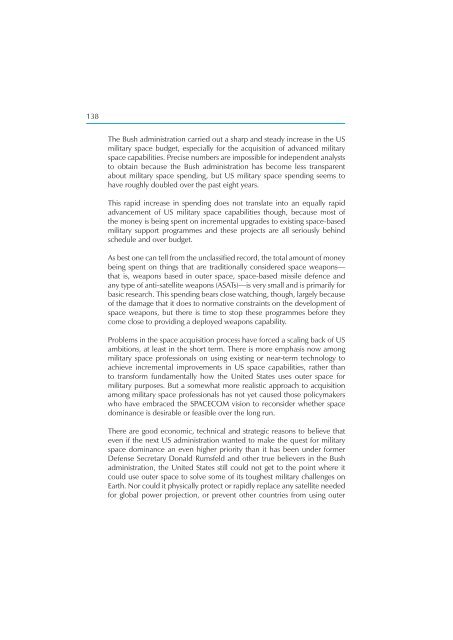Security in Space The Next Generation - UNIDIR
Security in Space The Next Generation - UNIDIR
Security in Space The Next Generation - UNIDIR
You also want an ePaper? Increase the reach of your titles
YUMPU automatically turns print PDFs into web optimized ePapers that Google loves.
138<br />
<strong>The</strong> Bush adm<strong>in</strong>istration carried out a sharp and steady <strong>in</strong>crease <strong>in</strong> the US<br />
military space budget, especially for the acquisition of advanced military<br />
space capabilities. Precise numbers are impossible for <strong>in</strong>dependent analysts<br />
to obta<strong>in</strong> because the Bush adm<strong>in</strong>istration has become less transparent<br />
about military space spend<strong>in</strong>g, but US military space spend<strong>in</strong>g seems to<br />
have roughly doubled over the past eight years.<br />
This rapid <strong>in</strong>crease <strong>in</strong> spend<strong>in</strong>g does not translate <strong>in</strong>to an equally rapid<br />
advancement of US military space capabilities though, because most of<br />
the money is be<strong>in</strong>g spent on <strong>in</strong>cremental upgrades to exist<strong>in</strong>g space-based<br />
military support programmes and these projects are all seriously beh<strong>in</strong>d<br />
schedule and over budget.<br />
As best one can tell from the unclassifi ed record, the total amount of money<br />
be<strong>in</strong>g spent on th<strong>in</strong>gs that are traditionally considered space weapons—<br />
that is, weapons based <strong>in</strong> outer space, space-based missile defence and<br />
any type of anti-satellite weapons (ASATs)—is very small and is primarily for<br />
basic research. This spend<strong>in</strong>g bears close watch<strong>in</strong>g, though, largely because<br />
of the damage that it does to normative constra<strong>in</strong>ts on the development of<br />
space weapons, but there is time to stop these programmes before they<br />
come close to provid<strong>in</strong>g a deployed weapons capability.<br />
Problems <strong>in</strong> the space acquisition process have forced a scal<strong>in</strong>g back of US<br />
ambitions, at least <strong>in</strong> the short term. <strong>The</strong>re is more emphasis now among<br />
military space professionals on us<strong>in</strong>g exist<strong>in</strong>g or near-term technology to<br />
achieve <strong>in</strong>cremental improvements <strong>in</strong> US space capabilities, rather than<br />
to transform fundamentally how the United States uses outer space for<br />
military purposes. But a somewhat more realistic approach to acquisition<br />
among military space professionals has not yet caused those policymakers<br />
who have embraced the SPACECOM vision to reconsider whether space<br />
dom<strong>in</strong>ance is desirable or feasible over the long run.<br />
<strong>The</strong>re are good economic, technical and strategic reasons to believe that<br />
even if the next US adm<strong>in</strong>istration wanted to make the quest for military<br />
space dom<strong>in</strong>ance an even higher priority than it has been under former<br />
Defense Secretary Donald Rumsfeld and other true believers <strong>in</strong> the Bush<br />
adm<strong>in</strong>istration, the United States still could not get to the po<strong>in</strong>t where it<br />
could use outer space to solve some of its toughest military challenges on<br />
Earth. Nor could it physically protect or rapidly replace any satellite needed<br />
for global power projection, or prevent other countries from us<strong>in</strong>g outer








